Day Two of the Tasting of the Year began quietly with a 1976 Krug, following an oxidized 1962 I believe. The nose on the Krug was lightly toasty with golden fruit, wafer, sugar and light petillance. The palate was creamy and tasty but on the mature side for a 1976. There were some comments about 1976 starting to turn the corner for Champagne (93).
Lunch was served first, and I was torn between White Bordeaux and Riesling for our first white wine. There was peach, petrol and wood for sure, but a gaseous element started to take over. There were also layers of lychee and lemon along with white forest. The palate was delicious, ‘fantastic’ to one. There was great balance in this long and elegant white, along with nice petrol flavors. It was more bitter after food, and SuperMario added ‘wet sea shell and orange blossom’ for the 1976 Hugel Riesling VT (93).
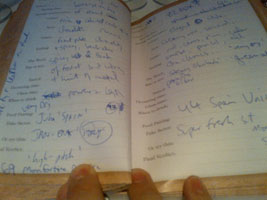
Hard at Work
A 1979 Trimbach Riesling Cuvee Frederic Emile was surprisingly bad. There was less petrol here and more forest along with sunned, yellow fruit. Mild and reserved, its palate was very dry and austere with glue flavors and no fruit. I thought it was a white Bordeaux, but this Riesling made me frown, and Juha added ‘too chalky’ (NR).
A 1992 Trimbach Riesling Clos Ste. Hune restored the reputation of the esteemed house of Trimbach. Its nose was a bit sweeter, again possessing petrol but also with some white Burgundy edges. There was nice richness and balance in this oily and viscous Clos Ste. Hune. Some food made it more citrusy, and it had great, lingering acidity (93).
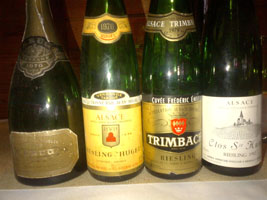
White Lightning
The reds began with an obscure yet ‘famous’ wine, per Pekka. Batman was on the case with ‘high acidity,’ definitely placing it outside the Bordeaux camp. I got cedar, chocolate and cassis, but who was I to question Batman? The palate definitely wasn’t Bordeaux, Nebbiolo I questioned? In a roundabout way, the wine was a combination of my instincts. There were earthy and chocolaty flavors along with sweet and sour cherry, and a dry, leathery finish. Someone observed ‘bitter dark chocolate,’ and Chianti was my last guess for this 1986 Isole E Olena Collexione di Marche Cabernet Sauvignon. I think it won some major tasting years that Pekka held years ago, but time had passed this wine by now, I guess. It was still good with nice acidity (90).
The nose on the second red reminded me of a Rhone wine, but it was deeper and more concentrated than the average one. Cuvee Cathleen crossed my mind. Its palate was big, beefy and roasted with a kiss of earth and a long, concentrated and smoky finish. Guesses were all over, including Italy. The wine was meaty and nutty and finished well with caramel kisses. It was a 1991 Pesquera Ribera del Duero Cuvee Janus. Someone said that Janus was a two-faced god who looked to the past and future at the same time. Deep (93).
The last two wines with lunch were paired with dessert, and the first had an apple cider nose that was quite exotic and noticeably different than any of the wines already served this weekend. It reminded me of Amarone on the palate, but it didn’t seem sweet enough. I was thinking it might have been 1990 Bonneau Cuvee Speciale actually, but this classy 1991 Quintarelli Amarone was drier than expected (92).
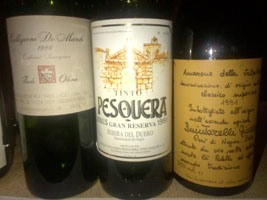
Pesquera & Isole & Olena & Quintarelli
I didn’t take a note for the Madeira Malvasia Velha bottled in 1954, as I didn’t want the sugar here to affect my palate after lunch. There was the tasting, after all.
We were back in the other room for the tasting portion of our Saturday marathon, and a magnum of 1976 Philipponat Champagne Clos des Goisses welcomed us to the second act of our day. I guessed Clos des Goisses, as I find its style easy to identify, at least the style of its recently disgorged bottles. This magnum was disgorged only two months prior, and Champagnes need much more time in the bottle after disgorgement to get the mature aromas and flavors out of them, at least in my opinion. The Goisses was grassy and fresh, pungent and vivacious with oodles of zip. It was a touch too grassy for me, and Juha noted ‘coffee’ (92+M).
The official first flight began with a forward and volatile wine. Aromas of hot tobacco, pungent rose and squashed tomato were joined by ‘balsamic’ and ‘dill’ from the crowd. The palate was lush and round with ripe, red, tangy flavors. Tomato and Worcestershire were present in this gamy, wild and exciting wine. It got a little orangey with some apricot jam, but it could do whatever it wanted as it was a 1960 DRC La Tache. This was impressive for a theoretically shit vintage; I don’t think I have ever even had a wine from 1960. Bucket list now shorter (93).
The second wine had a bit of sea breeze on top of peanut, along with chocolate and cabinet rack spice. The palate was round and spicy on the front and still spicy on its backside. More chocolate was on the palate, along with a touch of forest and nice citrus. It was very dry, clearly powerful and long. Juha guessed Spain, but Batman nailed it with Italy. There was high pitch and excellent acidity in this leathery 1969 Giacomo Conterno Barolo Monfortino Riserva (94).
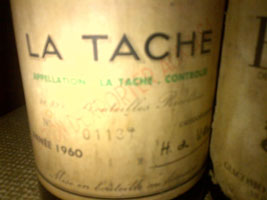
Bucket List Just Got Shorter
My biggest misfire of the weekend was when I convinced myself the next wine was a 1982 Bordeaux. It was a 1944 Vega Sicilia Unico lol. The wine was elegant and creamy, sensual with its nut, cassis, plum, cedar, smoke, pencil…’all the classics,’ I wrote . The stewy rhubarb, along with the ‘green oats,’ should have sent me elsewhere. This super fresh bottle was very dry, and very flamboyant (94).
I was convinced the 1997 Solaia was the 1997 Harlan. The nose was roasted coffee, asphalt, tar and melted chocolate. The palate was rich and long with nice expression of its tannins. It was hedonistic yet reined in stylistically. Batman found it ‘impressive but not my style. Difficult to like.’ I understood his point, as the modernish qualities of the Solaia seemed out of place, but it was difficult not to respect the wine, even if it was too soon and not the right place (94+).
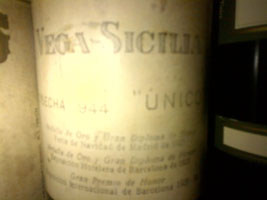
Not Your Average 1982 Bordeaux
Here was the 1982 Bordeaux, and it was a 1982 Leoville Las Cases. This wine has plummeted in value, making it practically half-price and a great buy in the market right now, as this bottle showed. It was elegant and young, with a feminine, musky and nutty nose. Dried herbs and green bean delicately danced about in this ‘very silky’ wine. It had a long and expressive finish, and I thought it was a Pichon Lalande at first, one of the great early drinkers from this vintage. Nice show (95).
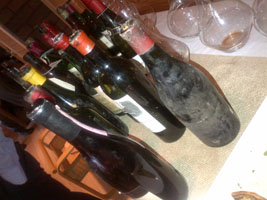
Getting Hectic
The first wine of the second flight had an exciting nose that was sexy, musky and full of tomato. There was this volatile Burgundy edge to it in that goody goody bloody bloody mary tangy way. The palate was delicious and extraordinary at first sip, but there were some awkward edges on its finishing flavors, and the wine quickly went the wrong way in the glass, falling apart. It is a difficult question as to what to score a wine like this, this 1911 Colcombet Musigny. Its initial impression flashed much higher potential, but it didn’t last long (90?).
The next wine was a corked 1915 Hospices de Beaune, Corton from someone you’ve never heard about, so good thing I don’t need that information since it was corked. The plastic wrap thing didn’t work or help either (DQ).
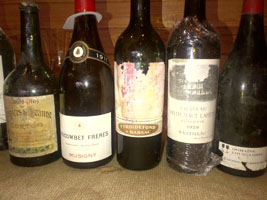
Almost Too Sexy
A nutty nose that was deep, heavy and rich had an oaky streak to it that I was hoping would blow off. The palate was more oaky, making this not my cup of tea. The oak eventually blew off, and this 1924 Margaux was pretty and fragrant (90).
A 1928 Smith Haut Lafitte was the definition of doctored. ‘Funny’ and ‘cheap candy’ came from the crowd. This was a wild and kinky wine, although I am not sure I could call it even that. There was nice definition to this reconditioned gone wild Bordeaux. The best way I could describe it is sour candy city with a touch of bathroom sex where the girl is sucking on sour apple and watermelon jolly ranchers at the same time. Amongst other things. The funny thing about it was that was exactly it (90?).
The 1905 Louis Jadot Charmes Chambertin was breathtaking wine, a veritable secret agent of the wine world, as its complex aromas and flavors touched many parts of the globe. Hints of Italy, Spain and the Rhone were all there; let’s hope figuratively. Its sweet nose was ripe and red, and its saucy palate was full of coffee flavors. It was ripe, rich and exciting, lush and oily with impressive acidity. Its flavors became more nutty and caramel-y in the glass, and this wine was good to the last drop. This was one of my wines of the weekend (96+).
A 1930 Pichon Lalande began the next flight seductively, and coffee was the first impression. Olive and a red and brown fruit mélange followed. There were flavors of wafer, tobacco and red citrus. The wine was in 92 point territory but fell a point every sip as the air attacked. Good thing I drank it in three sips. This was a solid effort given the fact that 1930 was about as difficult a vintage as you’ll find in the history of wine (90).
I generally love old Cvnes, but this 1951 Cvne Rioja Vina Imperial didn’t excite me as much as usual. There was this raw poultry aroma at first, but thankfully the nose got beyond that and opened into light citrus, wafer and street corner. Someone noted, ‘bloody steak’ (91).
The 1971 Gaja Sori Tilden was about as great an old bottle of Gaja that I have ever had. I can only think of a 1961 Barbaresco sampled fifteen years ago in the same arena. While the nose was volatile at first with a touch of bad breath, it blossomed into a musky, mahogany core. The wine was delicious and classic in many regards, as it had me thinking everything from 1951 BV Private Reserve (a legendary classic Cali) to Burgundy and home to Italy. There was a length and structure here that the other wines in this flight didn’t have, until the last one, at least (96).
I was ultimately surprised how good the 1973 Mouton Rothschild was. I was thinking 1971 Pomerol at first, as there was plump plum and nut aromas happening in its classy nose. The palate had garden and plum flavors, and while there was some greeny drama, this was an excellent and exceptional wine given the vintage. The magic of Picasso continues (Picasso designed the ‘artist’ label in 1973 for Mouton) (93).
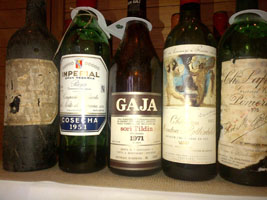
Line ‘Em Up
The 1975 Lafleur was black as midnight, so concentrated and rich. It was ‘a tannic pucker’ as one commented. Secondary aromas of leather, tar and mint gave way to flavors of tobacco, plum and more leather. Monstrously tight, it was hailed as ‘a voluptuous virgin,’ with decadent cherry flavors slowly emerging. This will be thrilling wine for decades to come. This was another wine of the weekend (96+).
A new flight turned out to have two of the weekend’s most legendary wines, even though neither made it into my weekend’s top wines. The first wines was another Cune, this time being a 1933 Cvne Rioja Vina Real. Again I was disappointed, as there was a metallic nose, with some Burgish fruit behind it. Suprisingly, it was Dirk Diggler’s favorite wine of the flight (90).
Don’t ask me how to explain the 1945 Chateau de Vosne Romanee Musigny. I can tell you there were aromas of garden, beef blood, iodine and mature Burgundy kink, with a wet kiss of volatility. The flavors were rich and sweet with orange, apricot, game and tang. Its acid lingered. The ‘sweetness of 1929’ was guessed, while ‘strawberry and rhubarb’ were noted. It was an excellent wine, although the mere existence of this wine seems counterintuitive (94).
There were lots of oohs and aahs for the next wine and its deep, chocolaty and motor oil nose. And why shouldn’t there be? It was a 1929 Petrus, after all. There was some fig to its molasses, and a 1947 Cheval-ish personality to this ‘very sweet’ wine. Its sweetness was actually the one thing holding it back a point or two (95).

Big Time Flight
The next wine was another super-concentrated wine that was earthy and a touch dirty in that diaper and band-aid direction. There were black fruits, and its dirty started becoming a good, nightclub dirty. The palate was rich and concentrated, a heavy wine with an ocean of fruit and penetrating acid. It was another wine of the century, a 1947 Cheval Blanc. It was also a reconditioned bottle. The wine was outstanding, but I remain convinced that this wine was at its best a little more than a decade ago (95).
I was convinced into believing the 1987 Gaja Sori San Lorenzo was a Cali Cab, even though my first instinct was Italy. Dangit! It was solid and leathery, dry and impressive for a vintage I have never seen or heard much about in Italy (93).
The notes started to fade, and the next flight was one of Port, beginning with a 1908 Warre’s Vintage Port that looked like a white port and perhaps was suffering a little bottle sickness. But for 104 years old, it got a round of applause (90).
I can’t tell you much about a 1917 Borges Soaltheira Vineyard Vintage Port except that I gave it (93).
I can tell you that the 1931 Niepoort Garrafeira Port was thrilling. It spent six years in wood before being bottled in 1938 in demi-john bottles, before being decanted into normal bottles in 1979. It was one of the best ports I have ever had, full of caramel and pepper, delicious yet most importantly smooth. The secret of the Garrafeira style is one that needs to be shared with the majority of the wine world! Thanks to Dirk Niepoort for this memorable experience. He was also the only winemaker in attendance (97).
A 1963 Cockburn’s Vintage Port was a bit young and sweet by comparison (91).
All I can tell you about the 1980 Quinto do Noval Vintage Port is that it was the best port from this obscure vintage (92).
Dinner started with a couple of less spectacular than usual Cristals. The 1979 Roederer Cristal had a grassy nose with white n yellow sugared fruit. It was a bit Dom-ish and Oeno-ish which is not the usual Cristal style. Still excellent, this is usually superior (94).
A 1989 Roederer Cristal Rose was a touch advanced and bretty. There was strawberry and citrus to its zippy fruit, but this was an off-bottle (92A).
A 1989 Roederer Cristal Rose was a touch advanced and bretty. There was strawberry and citrus to its zippy fruit, but this was an off-bottle (92A).
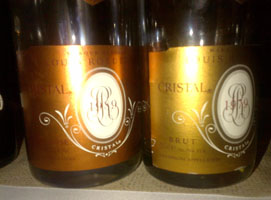
Cris-Crossed
The first, official flight was still Champagne, beginning with a 1926 Philipponat Demi-Sec Royale Reserve. This was the sweetest Champagne that I’ve ever had. It was caramel city with its smooth, browned flavors. It was balanced and mature to the brink but without being oxidized; it was an age thing. ‘So sweet’ and ‘mushroomy’ summed it up (92).
The color of the next Champagne was quite brown, but it had a more youthful personality than the 1926. It was grassy and full of straw and honey flavors with a coconutty finish. The finish was a touch oaky in this miraculous 1913 Mumm’s Cordon Rouge. It tasted three decades younger(93).
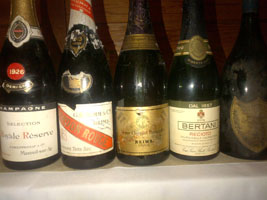
Bubbles!
A 1932 Veuve Clicquot had things like ‘pickled jalapeno’ and ‘leather couch.’ This was like a dry fino, and its overly tangy and bretty personality made me (DQ) it.
I guess the whole flight wasn’t Champagne, as we had a red sparkler, ‘Sparkling Shiraz,’ I wrote. It wasn’t bad, and while mature, there was still acidity there. Grapes, raisins and figs were present in this rich and drinkable 1965 Bertani Recioto Valpolicella Valpantena Riserva Spumante Naturale (90).
Unfortunately, a 1949 Dom Perignon was completely oxidized (DQ).
The first flight of whites began a wine that reeked of white Bordeaux. Glue and t n’ a were all over its powerful nose. Fresh paint and wax joined the party, but the palate in this 1981 Smith Haut Lafitte Blanc was austerely similar with some lime and pineapple flavors trying to fight through (89).
The next white was forward and sweet, exotic with its lanolin aromas and something crazy in the guava direction but not quite that, along with banana skin. The palate was semi-unpleasant; full and gamy in that banana peel direction. Dates and stew rounded out the palate, which ultimately disappointed, as I usually love this wine, almost every vintage. It was a 1986 Chave Hermitage Blanc (87).
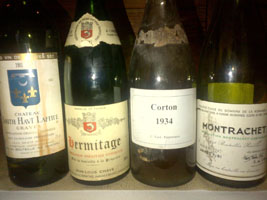
A Fascinating Flight of Whites
A 1934 Bouchard Corton Blanc had a metallic nose but a powerful palate. It had great acidity, but felt a bit fresh for 1934. It was reconditioned, as most bottles in the Bouchard cellar are. The palate was full of minerals, ice and fat skin, and this was certainly rich and sexy chardonnay that kept getting better and better (95).
The 1991 DRC Montrachet was guava city. It had a minty, Monty style with its big mouthfeel, and Juha noted ‘jasmine flavors.’ It was not the greatest example/vintage of this legendary wine (92).
There was a second flight of whites, and two were no good, starting with a 1942 Les Successeurs de J.M. Garnier Meursault (DQ).
The next wine had a Rhony kink but also had this older, buttery white Burg thing happening. It felt like it had the same top-off of the ’34 Blanc. It wasn’t as good as the ’34, but it was still solid with nice minerals to go with its butter flavors. ‘Tropical,’ ‘mocha’ and ‘roasted’ came from the crowd for this 1926 Leon Christophe Meursault (92).
White Bordeaux was my first guess when it came to the third white in this flight, as there were mature glue aromas, along with honeycomb and a bit of bikini wax. Its palate had lanolin, minerals and dry white fruit flavors, and more honeycomb. It was long, balanced and pretty, and I was impressed by this 1943 Staaterweinguter Steinberger Riesling Auslese. I wrote that it was amazing how Riesling and white Bordeaux flirt with each other after a lot of bottle age (94+).
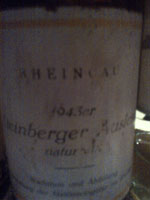
Ancient Riesling
Unfortunately, a 1958 Haut Brion Blanc was completely oxidized (DQ).
There was only one flight of reds left for the day, and we started with a ‘rocket ship’ of a 1983 Rousseau Chambertin. This bottle was quite vigorous, so much so I thought it might be from 1990. There were great rose, vitamin, perfume, waterfall, mineral and red fruit aromas. This was high-pitched in every which way, and there was citrus and depth to its palate. Its acid uncurled like a cobra, and ‘raspberry smoothie’ and ‘perfect’ came from the crowd. Its saucy finish had the topic of ‘kissemura’ making a comeback. I have had good luck with 1983 Burgs, and this was a fantastic bottle (95).
The 1992 Leroy Richebourg had so much cedar that it almost had me in Bordeaux territory, but the rose, blood and musk said Burgundy. It had a screechy nose, and an even tighter palate, although the wine did open on its finish more. Red citrus flavors were present, and while the wine was big in true Leroy fashion, the vintage’s shortcomings were evident (92).
The next wine had me guessing 1992 or 1994 Cali Cab. Don’t forget, we did know the vintages in each flight without knowing the wines or the order, so it was possible to make some decent deductions here and there. Charcoal and chocolate dominated its aromas, and blueberry and asphalt joined the party on the palate. This was a rich and concentrated wine, deep and heavy, long with excellent acidity. While the 1994 Harlan Estate Cabernet Sauvignon was hailed as a ‘powerful Cali,’ I also found it losing a step in the glass (94).
The next red had a grassier nose, along with band-aid aromas and a dirty birdie quality. The palate was similar to the Harlan with a different flavor profile, and its volume was less in every which way. Flavors of pepper, musk, earth and garrigue finished up this good but less complicated 1995 Chateau de Beaucastel Chateauneuf du Pape Hommage a Jacques Perrin (92).

Powerful Cali
SuperSomm noted ‘a hint of chicken shit’ in 1990 Jaboulet Hermitage La Chapelle. It had a buttery nose with percolating hints of acid, but its palate seemed really evolved and jammy. It was smooth and satiny, but I wanted and expected more from this wine (94).
One last flight of dessert wines? I think I can, I think I can. My notes were brief, apologies. A 1927 Broilo Vin Santo was white porty with a touch of morning mouth but uniquely excellent (93). A 1901 Bruder Gottdiener Ausbruch Imperial Tokaji had superb toffee flavors, ‘so good,’ I wrote. It had a thick and viscous texture (96).A 1927 Taylor’s Vintage Port was classic but not thrilling (94), and a 1936 Massandra Liveria Port was more similar to the Tokaji than the Taylor’s, despite sharing ‘Port’ in its name (94). A 1909 Filhot was disgusting, ‘RED CARD,’ I wrote in big letters. I wasn’t sure if it was the bottle or not, it had to be, so I gave it a (DQ), although it might be a (NR).
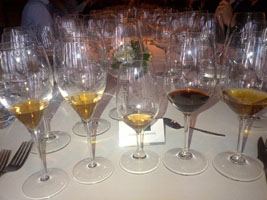
Small Sips Win the Race
And that was Day Two of the Tasting of the Year.
In Vino Veritas,
JK
